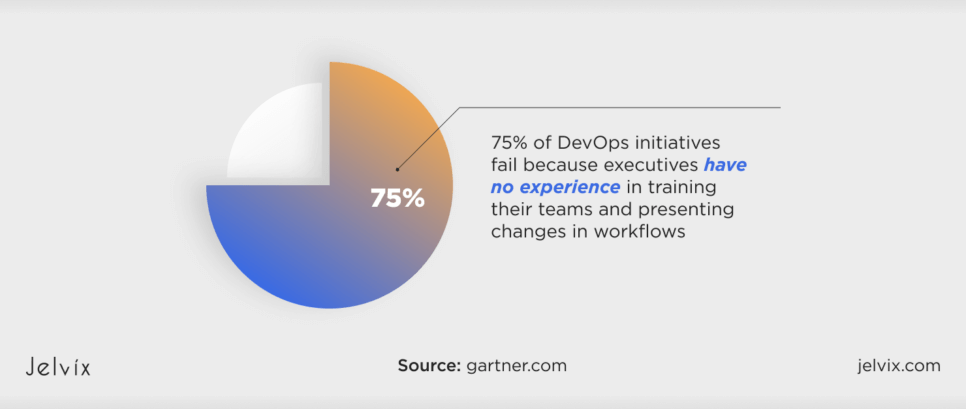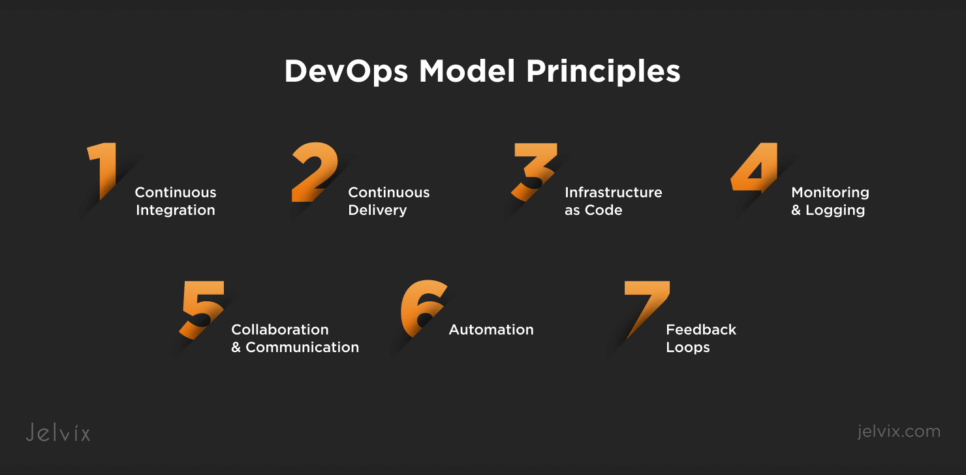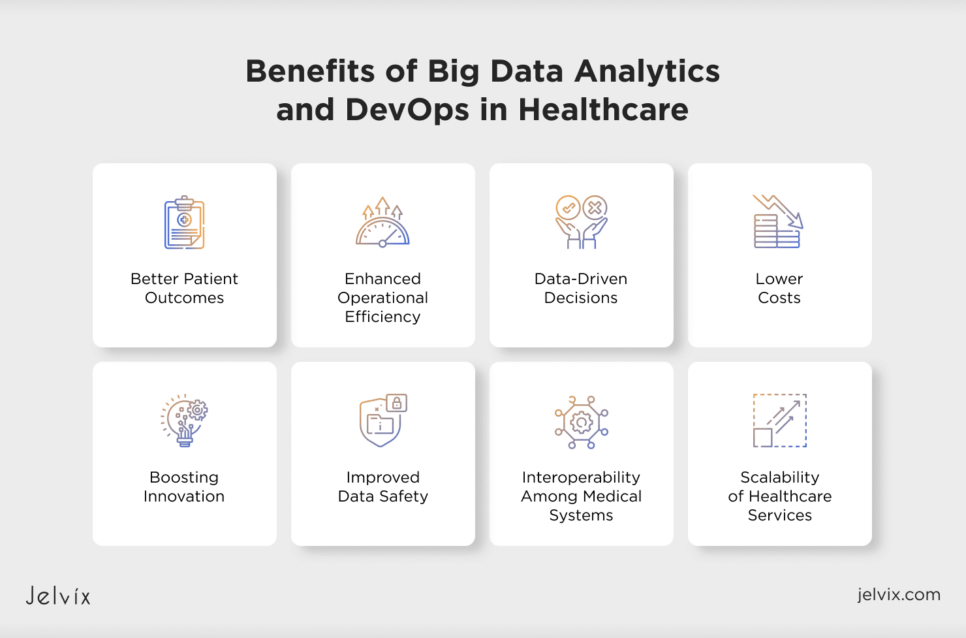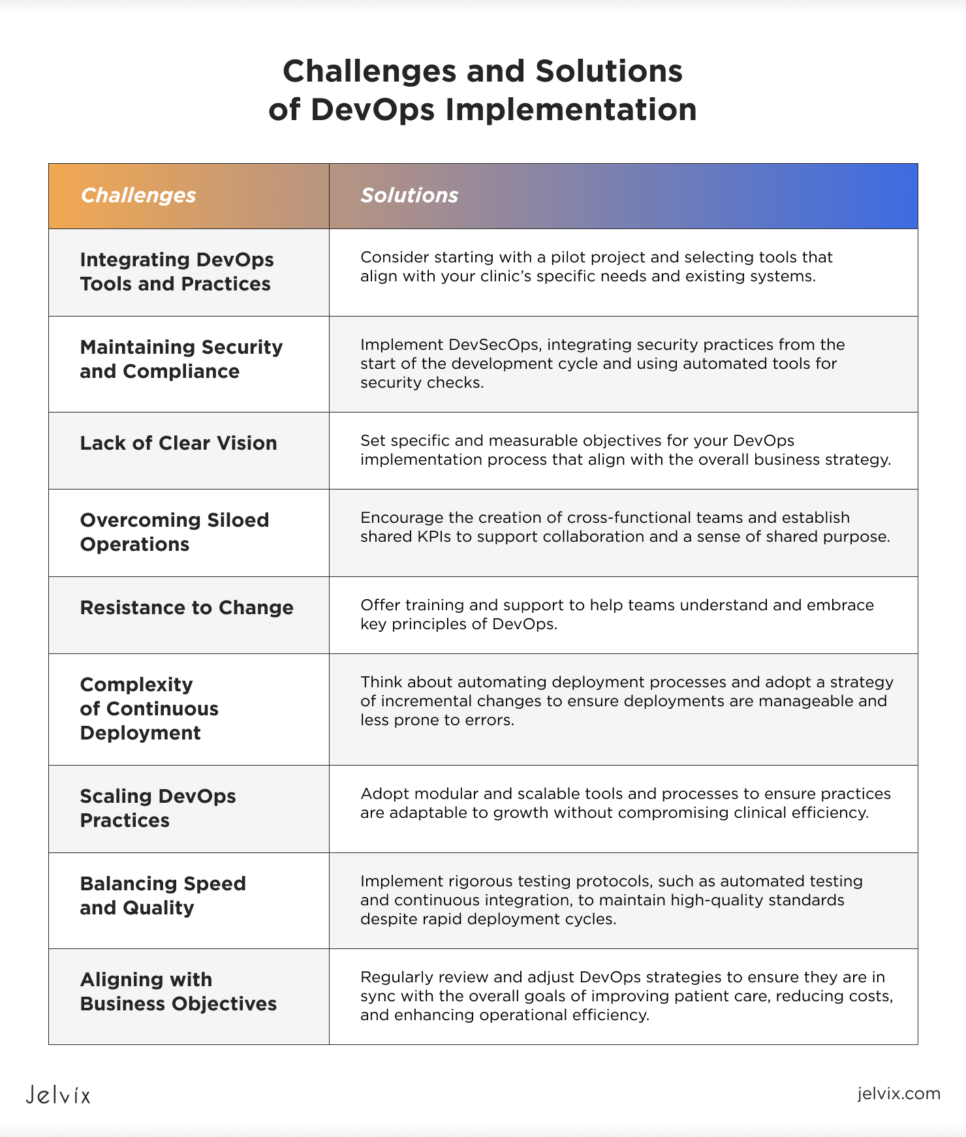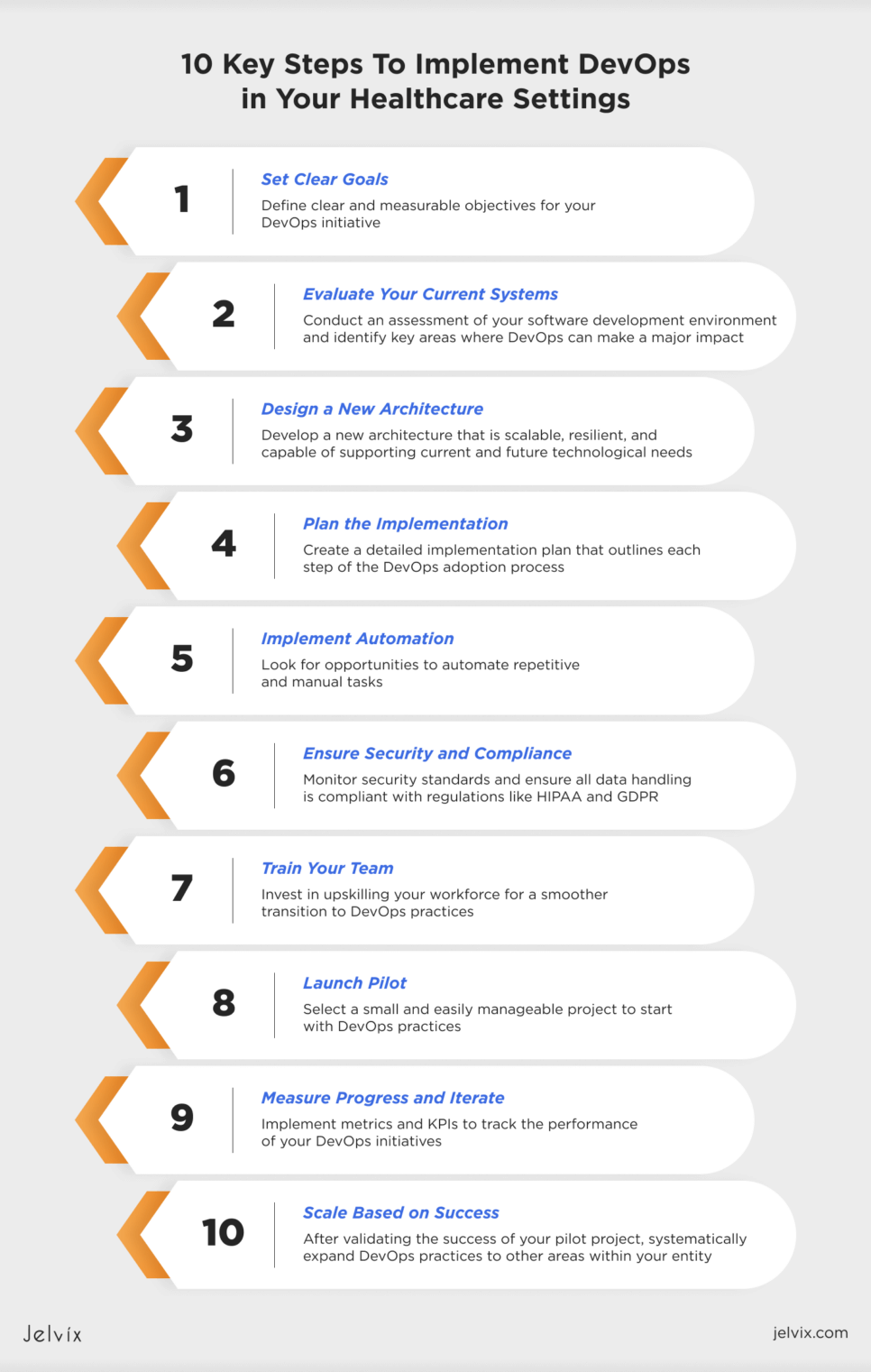The healthcare industry is undergoing a digital transformation, changing how clinics deliver care and manage operations. Many of them work with two or more database systems and see automation of common processes as a way out.
More companies implement the DevOps approach to facilitate automation and address the challenge of siloed healthcare teams. However, about 75% of DevOps initiatives fail because executives have no experience in training their teams and presenting changes in workflows.
If you seek to address communication gaps, enhance automation, and tackle data security issues by implementing DevOps, this article is for you. You’ll find out how to combine DevOps with data analytics for better care outcomes, what challenges lie ahead and ways to overcome them, and what steps to take for seamless DevOps implementation.
The Meaning of DevOps Principles for Healthcare
DevOps is a set of practices that combine software development (Dev) and IT operations (Ops). These practices are usually used to optimize business processes, support clinical interoperability, make collaboration among specialists easier, and speed up the delivery of tech solutions.
In healthcare, DevOps is often implemented to quickly respond to changing industry needs, ensure the safety of the delivered, and safeguard patient data from breaches. When properly implemented, DevOps can drive innovation in the healthcare industry and improve care delivery for patients.
DevOps Infrastructure Management: Model and Practices
As was noted earlier, DevOps represents a combination of practices that help healthcare entities automate clinical processes. The DevOps model involves several principles that help healthcare teams build, test, and release software faster and keep up with data safety standards.
Continuous Integration
Continuous integration (CI) is a principle that involves merging code changes into a central repository, where you run automated builds and tests. CI helps find and address bugs quickly. As a result, clinicians can improve the quality of their software and reduce the time taken to release software updates.
Continuous Delivery
Continuous delivery (CD) means automatically deploying all code changes to a testing or staging environment after the build stage. The main goal of CD is to have a codebase that is always in a deployable state. This way, it enables development specialists to release new changes quickly and safely whenever needed.
Infrastructure as Code
Infrastructure as code (IaC) is the process of managing infrastructures, such as networks, virtual machines, and load balancers, in a descriptive model, using code. This practice allows automation and securing of the infrastructure, enabling faster and more efficient provisioning of its resources. What’s more, this approach allows for quick infrastructure migration from one cloud to another using tools like Terraform.
Monitoring and Logging
Monitoring and logging practices involve the continuous monitoring of applications and infrastructure to detect and resolve issues promptly. It provides insights into the application performance and helps in understanding how changes or updates impact users.
Collaboration and Communication
The DevOps model supports the culture of collaboration among teams. It means that common processes like building, testing, and releasing software can happen rapidly, frequently, and reliably due to efficient communication among experts.
Automation
Automation is the basics of the DevOps model that covers all aspects of software development and infrastructure management. By automating repetitive tasks, teams can focus on more strategic work, reduce the scope for errors, and speed up the entire process of software delivery.
Feedback Loops
Instant feedback provides development teams with immediate insights into the impact of their work. This helps make adjustments quicker and enhances the quality of healthcare solutions.
Benefits of Big Data Analytics and DevOps in Healthcare
About 47% of companies started using the DevOps approach for software development. It’s no wonder, as DevOps can be truly transformative for healthcare companies, especially when combined with big data analytics. This powerful combination enables clinics to manage vast amounts of healthcare data, improving decision-making and speeding up the development of medical tech.
Better Patient Outcomes
With the help of big data analytics, healthcare pros can analyze vast datasets from various sources, including electronic health records, wearables, and remote patient monitoring devices. Combined with DevOps practices, these insights can be translated into actionable software features that make patient outcomes better.
Enhanced Operational Efficiency
DevOps practices speed up the software development lifecycle, which means quicker updates to critical software systems. Big data steps in to spot any hiccups in how hospitals work, suggesting fixes that can make waiting times shorter and treatment faster.
Data-Driven Decisions
Big data analytics provides a clear view of what’s going on and what might happen next in your clinical processes. When DevOps gets involved, hospitals can ensure that their software systems are optimized to use these insights effectively.
Lower Costs
When healthcare processes run smoothly and treatment gets smarter, costs go down. Fewer mistakes mean less money spent fixing them, and predictive analytics can help prevent expensive emergency care by catching problems early. What’s more, DevOps automation and improved workflows can significantly reduce administrative and operational expenses.
Boosting Innovation
With useful insights provided by big data, healthcare pros can spot trends, solve arising problems, and come up with new treatments faster. DevOps ensures that these innovations can be rapidly developed, tested, and deployed, making it easier for medical companies to stay competitive in the market.
Improved Data Safety
Handling health data requires strict adherence to industry regulations like HIPAA and GDPR. Big data helps monitor who’s accessing what, ensuring patient data is protected from unauthorized access. At the same time, DevOps allows building security features right into the software, protecting data against leaks and breaches.
Interoperability Among Medical Systems
Interoperability among disparate healthcare systems is critical for the seamless exchange of patient data. Big data analytics can help identify and resolve interoperability issues by analyzing how data flows between systems. DevOps practices contribute by enabling agile integrations of systems and help ensure that new and legacy systems can communicate effectively.
Scalability of Healthcare Services
As the volume of healthcare data increases, the need for scalable services becomes critical. Big data analytics helps by identifying capacity requirements and understanding usage trends. DevOps supports scalability which will be your long-term strategy for addressing growing market demands. It helps ensure your tech grows with your business and you remain responsive to varying patient needs.
Things To Consider Before Implementing DevOps in Healthcare
Rolling out DevOps in healthcare is a big move that requires careful planning, the right tools, and a skilled team. Before you go into this process, you have to understand its essential points.
Regulatory Compliance
Healthcare is full of rules, especially about keeping patient information safe. When setting up DevOps, make sure everything you do is in line with industry regulations if you want patient data to be protected.
Security from the Start
At least 541 data breaches happened in healthcare in 2023, with the biggest one having affected 11 million people. As you transition to DevOps practices, employ robust security measures from the very beginning. This will help protect your facility from the risks related to data breaches. Also, consider implementing DevSecOps (or integrating security into DevOps) – an approach that involves inserting security practices and tools into the CI/CD pipeline. This ensures that security considerations are integrated throughout the development process and not after its completion.
Automation with a Human Touch
Although DevOps is about automation, you need to keep up with the unique needs of your entity. Automate repetitive tasks, but keep the human element in mind, especially when it comes to patient interactions and clinical decisions.
Sustainability for Long-Term Goals
DevOps is a continuous process aimed at making clinical operations better. Create a sustainable DevOps environment to focus not only on immediate gains but also on maintaining agility over time. This includes investing in scalable infrastructure to support a culture of continuous improvement.
AI and Analytics Tools
Artificial intelligence and analytics offer wide opportunities for improving patient care and operational efficiency. They can help predict health issues before they happen and tailor treatments to suit each patient individually. Make sure your DevOps setup can handle these tools to provide cutting-edge and patient-centric healthcare services.
Skills Development
Healthcare tech constantly evolves and so should your DevOps methodologies. Encourage your team to stay informed of the latest trends, tools, and best practices through ongoing training and professional development. A culture that values upskilling will help your team use the full potential of DevOps.
Expert Assistance
Since DevOps is a completely new concept for some companies, it’s better to request expert assistance. Teaming up with an experienced healthcare technical partner can be a good idea to handle the complexities of implementing DevOps. Experts can not only provide guidance but also save you time and money.
If you struggle to implement DevOps in your current processes, reach out to the Jelvix team experts. They will help you understand where you are now and where you need to move and will provide you with guidance on DevOps integration.
The Smart Way to Choose – Download Your Guide to Selecting the Right Healthcare Tech Partner!

Challenges and Solutions of DevOps Implementation
Whatever new product, feature, or practice you implement in your healthcare settings, you will face issues that require prompt addressing. The challenges of DevOps integration are especially important, as this approach is aimed to change your clinical workflows drastically.
Integrating DevOps Tools and Practices
Choosing and integrating the right set of tools can be overwhelming, potentially complicating established workflows. Consider starting with a pilot project and selecting tools that align with your clinic’s specific needs and existing systems.
Maintaining Security and Compliance
Ensuring continuous security and adherence to regulations can be challenging in the fast-paced DevOps cycle. Implement DevSecOps, integrating security practices from the start of the development cycle and using automated tools for security checks.
Lack of Clear Vision
Without clear goals, DevOps initiatives can lack direction and fail to deliver expected results. Set specific and measurable objectives for your DevOps implementation process that align with the overall business strategy.
Overcoming Siloed Operations
Traditional organizational structures often slow down the cross-functional collaboration essential for DevOps. Encourage the creation of cross-functional teams and establish shared KPIs to support collaboration and a sense of shared purpose.
Resistance to Change
Adapting to the collaborative and fast-paced nature of DevOps can be difficult for teams used to working in traditional environments. What you can do is promote a culture of open communication and improvement. Offer training and support to help teams understand and embrace key principles of DevOps.
Complexity of Continuous Deployment
Continuous deployment can introduce complexity that may pose risks to system stability and reliability. Think about automating deployment processes and adopt a strategy of incremental changes to ensure deployments are manageable and less prone to errors.
Scaling DevOps Practices
As organizations grow, scaling DevOps practices becomes challenging. Adopt modular and scalable tools and processes to ensure practices are adaptable to growth without compromising clinical efficiency.
Balancing Speed and Quality
While DevOps aims to increase the speed of development and deployment, it is critical to maintain the quality of software and services. Implement rigorous testing protocols, such as automated testing and continuous integration, to maintain high-quality standards despite rapid deployment cycles.
Aligning with Business Objectives
DevOps initiatives must align closely with the business objectives of your healthcare organization. Regularly review and adjust DevOps strategies to ensure they are in sync with the overall goals of improving patient care, reducing costs, and enhancing operational efficiency. Use strategic planning sessions involving IT and business leadership to ensure alignment.
Explore the role of CPOE in modern healthcare, and learn how to seamlessly integrate CPOE into your existing systems while maintaining regulatory compliance.
How To Implement DevOps in Your Healthcare Settings: 10 Key Steps
To effectively roll out DevOps in your healthcare environment, the Jelvix team recommends following a detailed and step-by-step strategy. Make sure to consider both opportunities and challenges for the best results.
Step 1: Set Clear Goals
Define clear and measurable objectives for your DevOps initiative. This can be reducing the time to deploy new software updates, enhancing system uptime, or improving cross-team collaboration. These goals should align with the broader company’s aims, like enhancing patient care or optimizing operational efficiency.
Step 2: Evaluate Your Current Systems
Conduct an assessment of your software development environment to understand the technologies in use, workflow efficiency, and team dynamics. You need this understanding to identify key areas where DevOps can make a major impact on your workflows and to plan a detailed implementation strategy.
Step 3: Design a New Architecture
Develop a new architecture that supports DevOps principles such as continuous integration and delivery. This architecture should be scalable, resilient, and capable of supporting current and future technological needs. Ensure that it aligns with the healthcare regulations and standards for data security and patient privacy.
Step 4: Plan the Implementation
Create a detailed implementation plan that outlines each step of the DevOps adoption process. This plan should include timelines, resource allocations, and specific milestones for integrating new tools and practices. Consider potential risks and mitigation strategies to ensure a smooth transition.
Step 5: Implement Automation
Look for opportunities to automate repetitive and manual tasks. This will speed up clinical processes and reduce the chance of errors. The goal of implementing automation should expand to optimizing current operations and adding value to care delivery.
Step 6: Ensure Security and Compliance
Incorporate security and compliance considerations into your DevOps workflows. This includes using automated tools to monitor security standards and ensuring all data handling is compliant with regulations like HIPAA and GDPR. Security features, such as role-based access controls, data encryption, and multi-factor authentication, will help protect sensitive patient information from leaks.
Step 7: Train Your Team
DevOps brings big changes to how teams operate. That’s why its implementation should be supported by training and educational resources. Invest in upskilling your workforce for a smoother transition to DevOps practices, so that they can focus on meeting your organization’s business goals and care delivery.
Step 8: Launch Pilot
Select a small and easily manageable project to start with DevOps practices. This allows you to apply DevOps principles in a controlled setting, where you can quickly address challenges and evaluate the effectiveness of your strategies without process disruption. A successful pilot project will serve as a model for broader DevOps adoption across the whole organization.
Step 9: Measure Progress and Iterate
Implement metrics and KPIs to track the performance of your DevOps initiatives against your defined goals. Regular evaluation enables you to fine-tune your approach, making data-driven adjustments that enhance clinical efficiency.
Step 10: Scale Based on Success
After validating the success of your pilot project, systematically expand DevOps practices to other areas within your entity. Scaling involves not just broadening the use of DevOps tools and methodologies but also reinforcing the collaborative and agile culture that supports DevOps across wider teams and projects.
How Jelvix Can Help in Transforming Healthcare with DevOps
Lack of automation, siloed teams, and communication gaps can significantly slow down the progress of healthcare entities. Adopting DevOps supports the culture of collaboration among developers, operations, and healthcare pros, driving better patient outcomes.
If you aim to implement DevOps to successfully automate your clinical processes, expert assistance can be what you need. Reach out to our experts, and they will help you evaluate your medical system’s state, define its key needs and objectives for the future, and offer a detailed implementation plan based on your unique requirements.
Considering a tech collaboration?
Discover our healthcare software development services with our skilled team.


